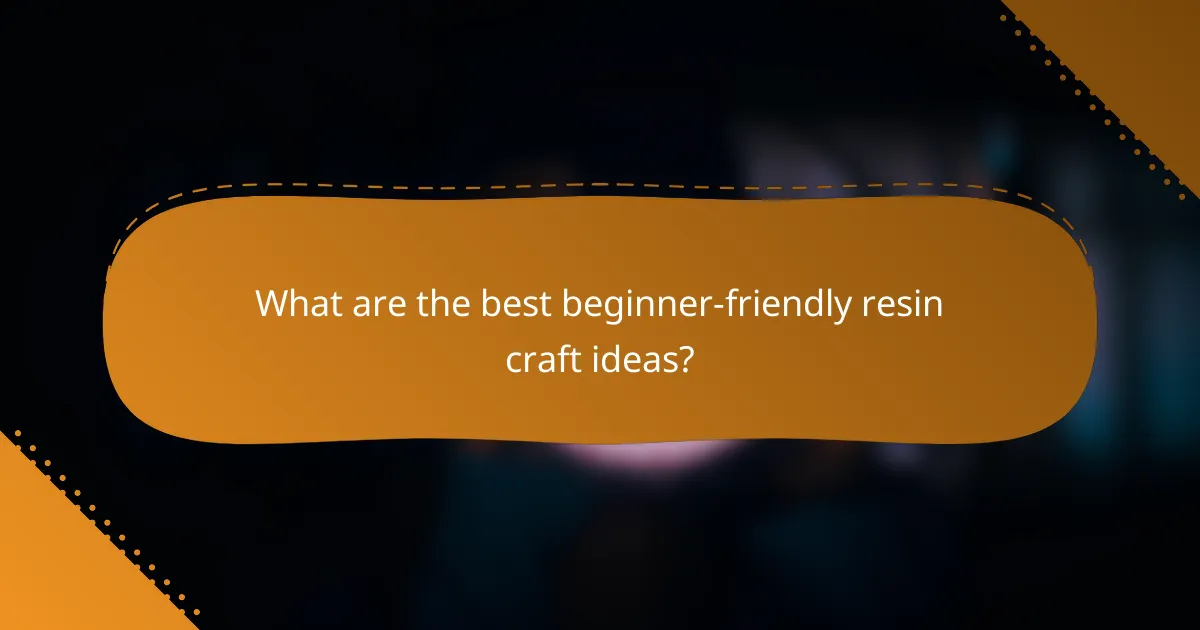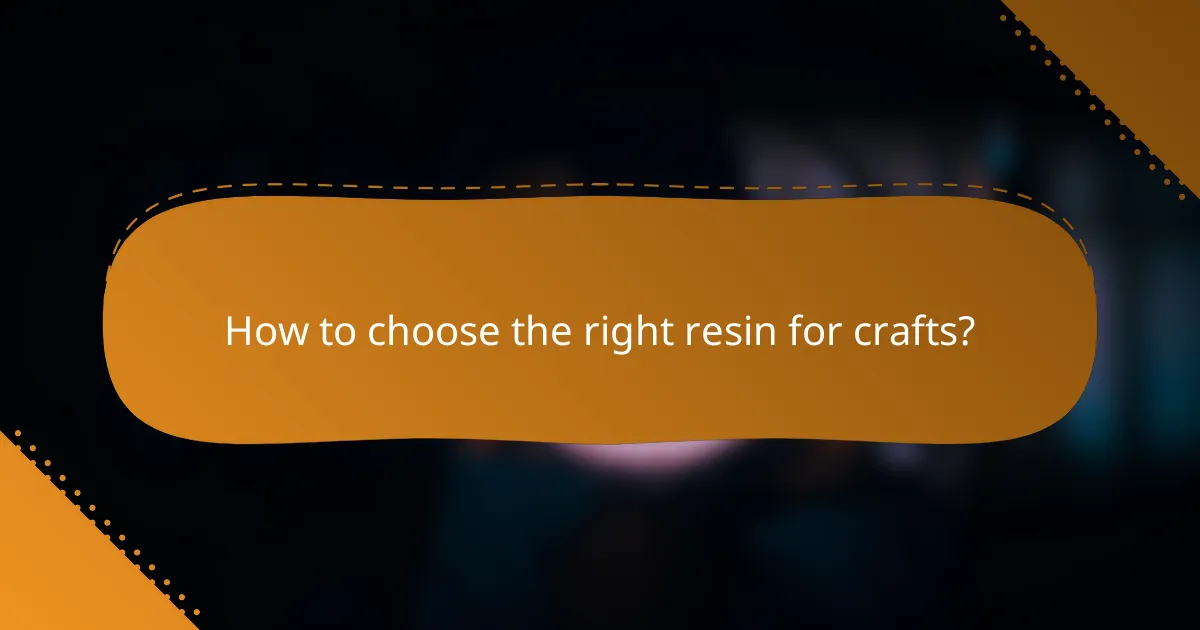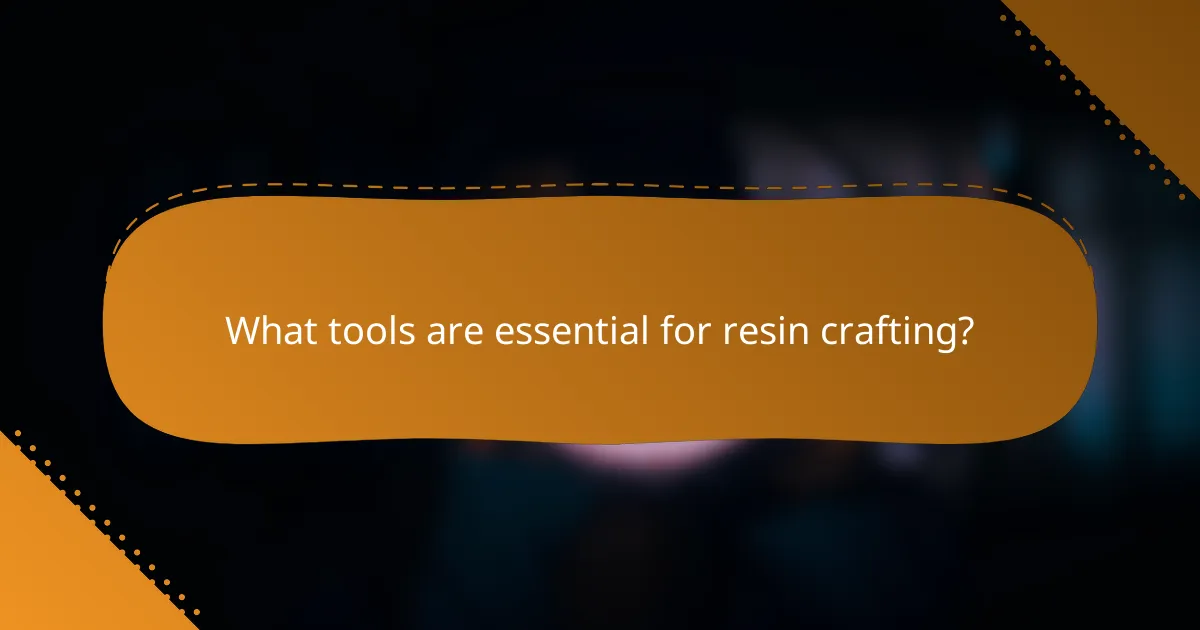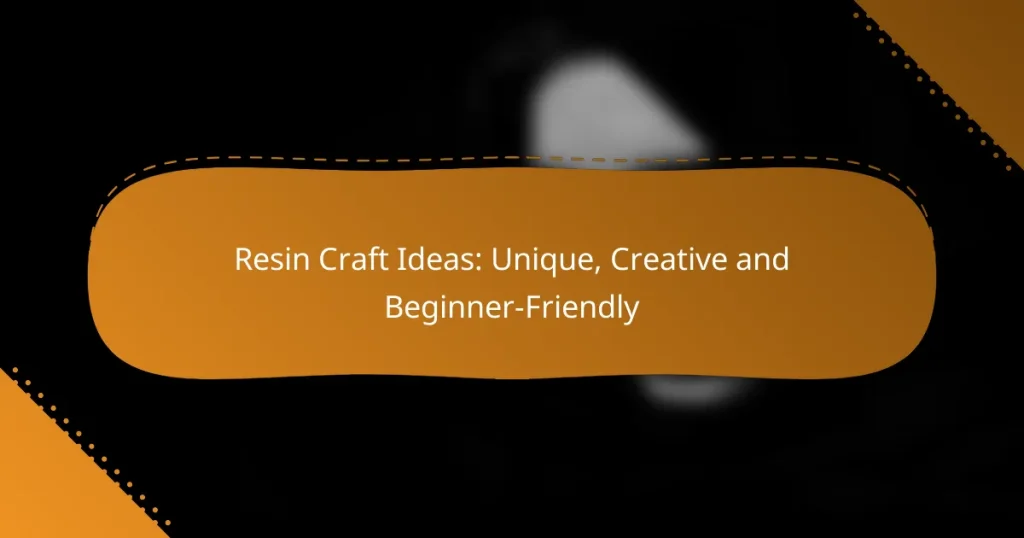Resin crafting offers a unique and creative outlet for beginners looking to explore their artistic side. With a variety of simple projects that require minimal materials, newcomers can easily dive into the world of resin pouring and finishing. By selecting the right resin and using essential tools, anyone can create beautiful, personalized pieces that showcase their creativity.

What are the best beginner-friendly resin craft ideas?
Beginner-friendly resin craft ideas include projects that are simple to execute and require minimal materials. These crafts allow newcomers to explore their creativity while developing essential skills in resin pouring and finishing.
Coasters with pressed flowers
Creating coasters with pressed flowers is an excellent way to combine functionality with beauty. Start by selecting flat flowers and leaves, then arrange them in a silicone coaster mold. Pour the resin over the flowers, ensuring they are fully submerged, and allow it to cure according to the manufacturer’s instructions.
Consider using a clear epoxy resin for a glossy finish that enhances the colors of the flowers. To prevent bubbles, pour slowly and use a heat gun or torch to pop any that form on the surface.
Resin keychains with charms
Resin keychains are a fun and practical project for beginners. Choose small charms or decorative items to embed in the resin, such as beads or glitter. Pour the resin into a keychain mold, place the charms, and then fill the mold to the top.
After curing, attach a keyring to complete the keychain. This project allows for personalization, so consider using colors or themes that reflect your style.
Decorative trays with glitter
Making decorative trays with glitter is a straightforward way to create eye-catching home decor. Select a tray mold and pour a layer of clear resin, then sprinkle glitter evenly across the surface before adding more resin to cover it.
Experiment with different types of glitter, such as fine or chunky, to achieve various effects. Ensure that the glitter is evenly distributed to avoid clumping, and allow ample curing time for a durable finish.
Resin bookmarks with colors
Resin bookmarks are a simple yet effective project that combines practicality with creativity. Use a bookmark mold and pour a base layer of colored resin, allowing it to partially cure before adding additional colors or designs.
Consider incorporating small items like dried flowers or glitter for added interest. Once fully cured, these bookmarks make great gifts or personal keepsakes.
Photo frames with embedded objects
Creating photo frames with embedded objects is a unique way to showcase memories. Choose a frame mold and arrange small items like shells, beads, or dried flowers within it. Pour the resin over the items, ensuring they are well covered.
Let the resin cure completely before removing the frame from the mold. This project allows for customization, so feel free to experiment with different themes or color schemes to match your decor.

How to choose the right resin for crafts?
Choosing the right resin for crafts involves understanding the specific properties and applications of different types of resin. Consider factors such as durability, curing time, and project size to select the best option for your needs.
Epoxy resin for durability
Epoxy resin is known for its exceptional strength and durability, making it ideal for projects that require a long-lasting finish. It is commonly used in furniture making, jewelry, and art pieces that need to withstand wear and tear.
When working with epoxy, ensure proper mixing ratios and allow ample curing time, typically ranging from 24 to 72 hours. This will help achieve optimal hardness and clarity.
Polyester resin for quick curing
Polyester resin is favored for its fast curing time, often setting within minutes. This makes it suitable for projects that require a quick turnaround, such as molds or castings.
However, polyester resin can emit strong fumes and may require proper ventilation during use. It is also less flexible than epoxy, which can lead to brittleness in certain applications.
UV resin for small projects
UV resin is perfect for small crafts and quick repairs, as it cures almost instantly when exposed to UV light. This makes it a popular choice for jewelry making and small decorative items.
Keep in mind that UV resin is best for projects that will not be exposed to direct sunlight for extended periods, as prolonged UV exposure can degrade the material. Always follow the manufacturer’s instructions for optimal results.

What tools are essential for resin crafting?
Essential tools for resin crafting include mixing cups, stir sticks, silicone molds, a heat gun, and protective gear. These items help ensure successful projects while maintaining safety and efficiency during the crafting process.
Mixing cups and stir sticks
Mixing cups and stir sticks are crucial for combining resin and hardener in the correct ratios. Use clear plastic or silicone cups to easily see the mixture and avoid contamination from previous uses. Stir sticks should be disposable or reusable, allowing for thorough mixing without introducing air bubbles.
Consider using graduated mixing cups for precise measurements, especially when working with larger batches. A common practice is to mix in small quantities to avoid waste and ensure the resin cures properly.
Silicone molds for shaping
Silicone molds are versatile tools that help shape resin into various forms, from coasters to jewelry. They are flexible, making it easy to remove the cured resin without damaging the finished piece. Look for molds designed specifically for resin to ensure compatibility and durability.
When selecting molds, consider the size and complexity of your designs. Simple shapes are ideal for beginners, while more intricate molds can offer advanced crafting opportunities as skills improve.
Heat gun for bubble removal
A heat gun is an effective tool for removing bubbles from resin after pouring. By gently applying heat to the surface, trapped air bubbles rise and pop, resulting in a smoother finish. Use the heat gun at a safe distance to avoid overheating the resin.
For best results, apply heat shortly after pouring the resin into the mold. This technique can significantly enhance the clarity and overall appearance of the final product.
Protective gear for safety
Protective gear is essential when working with resin to ensure safety. This includes gloves, goggles, and a mask to prevent inhalation of fumes. Always work in a well-ventilated area to minimize exposure to potentially harmful chemicals.
Investing in high-quality protective equipment can prevent skin irritation and respiratory issues. Regularly check your gear for wear and replace it as needed to maintain safety standards during your crafting sessions.

How to prepare a workspace for resin crafting?
Preparing a workspace for resin crafting involves ensuring safety, cleanliness, and organization. A well-set area will help you work efficiently while minimizing risks associated with resin materials.
Use a well-ventilated area
Working with resin releases fumes that can be harmful if inhaled. Choose a location with good airflow, such as a garage or outdoor space, to help disperse these fumes. If indoors, consider using fans or opening windows to enhance ventilation.
Using a respirator mask designed for organic vapors can further protect your health. Always prioritize your safety by ensuring that the area is free from any potential hazards.
Cover surfaces with plastic sheets
Resin can be messy, so protecting your work surfaces is crucial. Lay down plastic sheets or drop cloths to catch any spills or drips. This will make cleanup easier and prevent damage to your furniture or flooring.
Consider using disposable table covers for quick cleanup after your project is complete. Ensure that the plastic sheets are secured to prevent them from shifting during your work.
Organize tools and materials
Before starting your resin project, gather all necessary tools and materials. This includes mixing cups, stir sticks, gloves, and any molds or embellishments you plan to use. Keeping everything within reach will streamline your crafting process.
Use trays or containers to organize smaller items, and label them if necessary. A tidy workspace not only improves efficiency but also reduces the risk of accidents while handling resin.

What are common mistakes in resin crafting?
Common mistakes in resin crafting can lead to unsatisfactory results, wasted materials, and frustration. Understanding these pitfalls can help beginners achieve better outcomes and enjoy the process more.
Not measuring resin accurately
Accurate measurement of resin components is crucial for successful curing and achieving the desired finish. Most epoxy resins require a specific ratio of resin to hardener, typically around 1:1 or 2:1, depending on the product. Using a digital scale or measuring cups can help ensure precision.
Failing to measure correctly can result in issues like incomplete curing, sticky surfaces, or even excessive heat generation during the curing process. Always double-check your measurements and consider using a mixing stick to scrape the sides of your container to ensure all material is combined.


